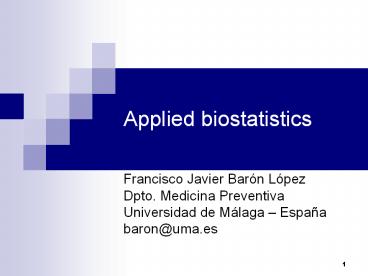Applied biostatistics - PowerPoint PPT Presentation
Title:
Applied biostatistics
Description:
Title: Bioestad stica Author: Francisco Javier Baron Lopez Last modified by: baron Created Date: 9/14/2006 9:16:08 PM Document presentation format – PowerPoint PPT presentation
Number of Views:103
Avg rating:3.0/5.0
Title: Applied biostatistics
1
Applied biostatistics
- Francisco Javier Barón López
- Dpto. Medicina Preventiva
- Universidad de Málaga España
- baron_at_uma.es
2
Classical hypothesis tests
- Comparing two groups
- A group receive a treatment.
- Other group receives placebo treatment.
- The outcomes are similar?
- How is the outcome measured?
- Numerically
- t-test (students t)
- Binary outcome Yes/No, Healthy/Sick,
- chi-squared
3
Numerical outcome
- Problem
- The numerical differences obtained when comparing
two treatments are big enough to attribute it to
random sampling? - Classiffication
- Independent samples
- Paired samples
4
Paired samples
- How
- We have two measurements of the same individual
- We have couples of similar individuals (matched
study)
5
Paired samples
- Null hypothesis
- Mean difference among paired observations is 0
- We reject it when p is small (plt0.05)
- Two approaches
- Parametric (t-test)
- Non parametric (Wilcoxon)
6
Example Paired samples
- Compare production yield of two types of corn
seed. - Type of seed will have influence but others
things too - Sun, wind, cropland
- Idea Lets test the two types of seed in the
same conditions
7
Example Paired samples
8
Independent samples
- Research question
- Calcium intake lowers blood pressure?
- Material and methods
- Two samples of individuals (independent)
- Experimental (calcium intake)/Placebo
- There must be some difference among means, Can
they be explained by random chance? - We choose a statistical test and compute
significance (p). - When p is small (plt0,05) we have evidence for
differences not random Calcium intake have a
signifficant effect on blood pressure.
9
y ahora la inferencia
10
Independent samples
- Null hypothesis
- There are no difference among groups
- Two ways of computing signifficance
- Parametric (T- Student)
- Non parametric (Wilcoxon, Mann-Whitney)
11
Example Independent samples
- We think that calcium intake decreases blood
pressure. To test it, we use two groups of
similar people to do an experiment - Experimental group 10 individuals, 3 months of
treatment. We measure the difference (change in
blood pressure) - Before After
- Control group 11 individuals, placebo for 3
months.
12
Validity conditions t-test
- Similar dispersion homoskedastics.
- Normality
- Kolmogorov-Smirnov
13
Normality condition
14
Numerical variable compared in 3 groups
- Research question
- When comparing means if 3groups, can we
attribute the differences JUST to hazard? - Generalizes t-test.
- Numerical variable that measures outcome is
called dependent - Numerical
- Variable that classifies individuals in groups
factor - Qualitative
15
3 independent samples
- Null hypothesis
- There are no differences among the groups
- Two ways of computing signifficance
- Parametric One-way ANOVA
- Non parametric Kruskal-Wallis.
16
Example 3 independent samples
- Experiment to compare 3 reading methods
- Random assignment
- 22 students in each group
- We measure several variables, before and
after (pre-test/post test). The outcome is the
difference (numerical variable)
17
Design problems?
- Do they had the same value before?
- No evidence against (p0,436)
18
Validity conditions for ANOVA
- Similar variability Levenes test (we want
pgtgt0,05) - Normality in each sample (pgt0,05)
- Conditions can be violated if sample sizes are
big.
19
And now the interesing part
- Are the differences significant?
20
(No Transcript)
21
A posteriori-analysis
- Planned comparisons
- You need to justify them a priori.
- Post-hoc comparisons
22
Non parametric version of ANOVA Kruskal Wallis































